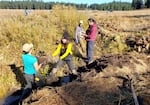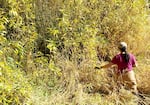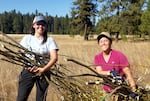If you want to emulate a beaver, you have to make friends with one of their favorite foods: willow shoots.
“I call them magic sticks — just plant them in the mud and they start to grow,” said Jeanine Moy, education program director for Vesper Meadow, a restoration demonstration site on the Howard Prairie Plateau, about 30 minutes east of Ashland. It was mid-October, and Moy had recruited volunteers for a work party called Beaver Days.
One group was to harvest willow stakes, which would later be planted along bare stretches of Latgawa Creek, which runs through the long meadow.
“Be sure to cut them at an angle near the base,” she instructed the willow group. “And don’t forget your t-shirt!” She said, pointing to the pile. Bring back the beaver, the shirts read, above a sketch of the iconic rodent.

During Beaver Days, volunteers use clods of earth, tree branches and small logs to build structures in the creek channel.
Juliet Grable/Jefferson Public Radio
For four years, Moy has led programming to restore, monitor, and explore Vesper Meadow. The picturesque expanse of grassland is bisected by Dead Indian Memorial Road. One of her prime objectives has been to restore Latgawa Creek and set the table for the beaver’s return.
The volunteers, which included the meadow’s landowners, Cory Ross and Greg Conaway, fanned out into a marshy thicket, where the narrow-leaved willows towered over their heads. Some volunteers cut and bundled stakes, while others dragged the piles up to the highway, where a pick-up truck waited.
It was an unusually warm fall day. Pale yellow grasses waved in the gentle breeze, and the bare cone of Mt. McLoughlin baked under a cloudless sky. Moy was grateful for the pleasant weather and her eager volunteers, and she was doing a good job of hiding her disappointment. Her original plan for Beaver Days was to build three dozen low-tech wood structures in Latgawa Creek. The structures — layers of mud, branches, and small logs, fastened in place with posts — would slow down the flow of water, carve new curves into the banks, and provide wet, muddy places for streamside plants to grow. Building them was an important part of her plan for restoring Vesper Meadow to the juicy, wet meadow it once was.
But while the log structures were uncomplicated, getting permission to build them was anything but. Moy had spent two years complying with permitting agencies; all she needed was a permission letter from FEMA on whether her project would meet the standards of the National Flood Insurance Program.
It hadn’t come.
“I’m trying not to stew on it,” said Moy. “But we only have a limited amount of time to do this work before it starts snowing.”
A shared vision
In 2018, Moy was serving as outreach director for the nonprofit Klamath-Siskiyou Wildlands Center, but she wanted to create a program or organization of her own that reflected her holistic vision of conservation — one that elevated art along with science, educated people while building community and restored cultures as well as ecosystems.
She met Ross while teaching a class for older adults at Southern Oregon University. Ross recalls how Moy described that healthy landscapes can act like sponges, slowing and soaking up water.
“That really spoke to me,” says Ross. “Water is so scarce now.”
Ross and Conaway were comfortably retired, and with money in the bank from a house sale in California, they wanted to give back. “We were looking at what we could do with climate change and community building that would be gratifying and open up opportunities for a lot of people,” says Ross, who is nearly 70. She and Moy decided to partner on a project: Ross would acquire a parcel of land ripe for restoration; Moy would live onsite, develop programming and raise funds.
That year, Ross and Conaway purchased 323 acres and worked with the Southern Oregon Land Conservancy to place all but seven in a conservation easement. They named it Vesper Meadow, after the vesper sparrow, a grassland bird discovered there during surveys.

Jeanine Moy, Vesper Meadow’s education director, wades into a willow thicket.
Juliet Grable/Jefferson Public Radio
If you glimpse Vesper Meadow from the highway, you’ll likely see a lovely expanse of open space that’s dotted with wildflowers in early summer and blanketed in snow in winter. It’s hard to spot the degradation unless you know what you’re looking for.
Thanks in large part to beavers, Vesper Meadow was once a complex, wet meadow, says Sarah Koenigsberg, communications director for The Beaver Coalition, a nonprofit focused on promoting beavers as agents of conservation. “The water table was right near the surface, and there were lots of teeny tiny channels and rivulets and wet swampy areas,” she explains. Conifers, which don’t like “wet feet,” grew further upslope, but aspen, willows, and camas thrived in the meadow. Several groups of indigenous people, including Shasta, Latgawa, and Takelma, likely harvested camas and other foods, gathered seeds, and managed the land with fire.
Native people were forcibly removed to the Siletz and Grande Ronde reservations in the 1850s. European settlers trapped out most of the beavers, setting off the transformation of the wet meadow into a dry one. “Their dams started breaking apart,” says Koenigsberg. “When you had gushes of water in winter and spring, instead of hitting a series of beaver dam speed bumps, it would rip down the creek and start eroding the fine-grained soil in the banks.” A feedback loop developed: more erosion meant faster flows which meant more erosion.
Other actions sped the transition. In the 1960s, the Bureau of Reclamation built a water diversion on the creek to feed a regional irrigation project. In the 1970s, landowners removed all the willows from a two-mile stretch of creek. Cows grazed and trampled the banks. The creek straightened and dropped below the floodplain, forming a mini-canyon. The meadow dried out. Exotic plants moved in. The aspens languished.
As soon as the sale of the meadow went through, Moy and the landowners went to work. Conaway, whose career as a pilot gave him a bird’s eye view of the drying West and grazing damage, put in many hours building structures and mending fences to keep cows out. In 2021, the couple purchased additional forested parcels next to Vesper Meadow, including an 80-acre clear-cut. They plan to eventually put these in a conservation easement as well.
Snagged by red tape
To slow the erosion along Latgawa Creek, Moy and an army of volunteers immediately started planting willows. Willow planting is a time-honored restoration strategy, and you don’t need a permit to plant them.
But Moy wanted to do more.
“The waterway being so degraded and showcased with the highway running through it lends itself to being a restoration demonstration site,” she explains.
Moy quickly honed in on bringing beavers back to Vesper Meadow. Not only do beaver-managed landscapes support a variety of plants, animals, and pollinators, they also help buffer the land during droughts and can even slow down or stop a wildfire.
But you can’t just drop a bunch of beavers off in a dry meadow, says Koenigsberg. “There’s no food. They’d starve, or get eaten by predators.” First, you have to set the table.
After talking with experts from The Beaver Coalition and NOAA, Moy decided to use a low-tech strategy called process-based restoration. It doesn’t require heavy equipment or engineering degrees, just lots of human hands. She started planning the log structures in the summer of 2020.

Stasie Maxwell, Indigenous Partnerships Program Manager, and Education Director Jeanine Moy with a fresh harvest of willow stakes.
Juliet Grable/Jefferson Public Radio
Sheri Hagwood, Partners for Fish and Wildlife botanist with the US Fish and Wildlife Service, suggested Moy apply for funding and technical assistance through the Partners for Fish and Wildlife program, which helps private landowners enhance their properties for wildlife.
Vesper Meadow received $36,000 through the Partners program (and matched it with over $37,000). Hagwood helped Moy with planning and permitting. To build the structures, she needed to obtain a host of permits from federal, state, and county agencies, which evaluate everything from water quality to the project’s impact on cultural resources.
Moy bumped into the FEMA requirement when applying to Jackson County for a floodplain development permit. Part of the meadow was a FEMA-mapped flood zone. An engineering analysis showed that during a hypothetical “100-year” flood, her project would raise the water level in one part of this zone by 8 inches, which the county didn’t allow.
According to Moy, the flood map didn’t match what was actually on the ground. Her only course of action was to apply to FEMA to revise the map and show that no homes or other buildings would be threatened by her project.
“The whole FEMA process is in place to protect homeowners from flooding, but there are no other homes anywhere near this floodplain,” says Moy. “It just seemed excessive for us to be able to put some sticks in the creek.”
She used part of her budget to hire an engineer to map and analyze the creek. Finally, last November, they mailed the application to FEMA.
After a few months, she followed up. FEMA had never received her materials. She sent them again. For the next several months, the FEMA representative and her engineer went back and forth with requests and revisions. With the weather window for building the log structures closing, Moy planned Beaver Days.
Moy’s efforts — and her frustration — highlight a key barrier to getting more restoration done on privately owned land, says Koenigsberg. “So often we have good regulations and good permitting processes when the presumption is that the human action is causing harm,” she says. “But we’re putting restoration projects through the same scrutiny. We believe we need to do everything we can to create expedited permitting pathways and greenlight these projects.”
Restoring ecological functions
On Oct. 24, a week after Beaver Days, Moy finally received her letter from FEMA. A crew from The Beaver Coalition was already working in the creek when a new crop of volunteers arrived the next day. The weather had turned, and Mt. McLoughlin wore a fresh cloak of snow.
Andrew Schwarz, the project coordinator for The Beaver Coalition, stood in the creek in muck boots, directing construction of the first of the long-awaited wood structures. Some worked on dry land above the creek, buzzing off side branches from a pile of small conifers and sloughing off chunks of creek bank with shovels. Others formed a train, passing the clods from the bank down to the messy structure taking shape at Schwarz’s feet.
Schwarz layered material like a lasagna: clods first, then “fluffy stuff” — small, fine branches cut from the main trunks of small trees — then more clods and a layer of larger branches. Finally, Schwarz wedged in the saplings, weaving in smaller branches to help stabilize them.

Landowners Greg Conaway and Cory Ross load willow stakes into a pickup truck.
Juliet Grable/Jefferson Public Radio
Water immediately began pooling up behind the structure.
The next day, Schwarz and his team came back and pounded posts into the structures. Once a heavy rain fills the creek, chunks will likely break loose.
That’s okay, says Koenigsburg. “We’re wanting these things to fall apart. The creek is meant to be dynamic and change over time.”
This attitude is a hallmark of process-based restoration, which is less about building permanent structures and more about restoring functions. Seeding the creek with branches, vegetation, and rocks will help retain water on the landscape. In the best case, beavers, lured by water and their favorite foods, will return and take over the maintenance of the meadow. They could also be deliberately reintroduced, though this would require a separate permitting process.
It’s humbling to admit that a rodent can do this work better than we can, says Koenigsburg. “This kind of restoration challenges human nature,” she adds. “We like control and we don’t like messy. But we’re at this turning point: Do we want control, or do we want water, biodiversity, and firebreaks?”
Moy’s plan is not to hand the meadow off to beavers and leave. A key part of her programming is to restore human presence to Vesper Meadow, using art, education, science, and hands-on work to draw people in. Vesper Meadow helped cofound the Indigenous Gardens Network and has invited Siletz and Grande Ronde tribal members to reconnect with a landscape their ancestors knew intimately.
“More and more I use the term biocultural restoration,” says Moy. “It’s not just humans visiting and restoring and measuring [Vesper Meadow] but rather building personal relationships with the land and tending it over time.”

